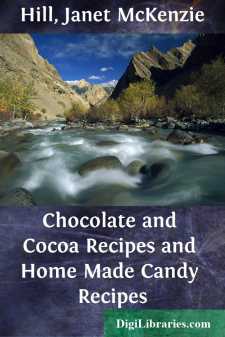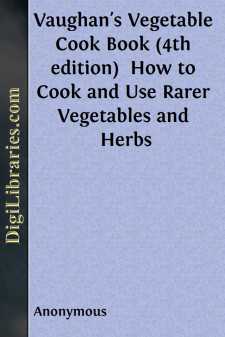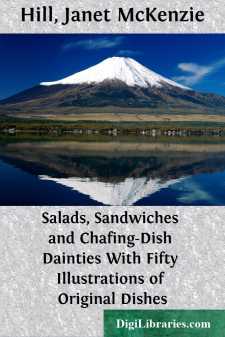Cooking
- General 70
- History 1
- Reference 10
- Regional & Ethnic 3
- Vegetarian 10
Cooking Books
Sort by:
by:
Harry Snyder
CHAPTER I GENERAL COMPOSITION OF FOODS 1. Water.—All foods contain water. Vegetables in their natural condition contain large amounts, often 95 per cent, while in meats there is from 40 to 60 per cent or more. Prepared cereal products, as flour, corn meal, and oatmeal, which are apparently dry, have from 7 to 14 per cent. In general the amount of water in a food varies with the mechanical structure...
more...
Cocoa and Chocolate The term "Cocoa," a corruption of "Cacao," is almost universally used in English-speaking countries to designate the seeds of the small tropical tree known to botanists as THEOBROMA CACAO, from which a great variety of preparations under the name of cocoa and chocolate for eating and drinking are made. The name "Chocolatl" is nearly the same in most European...
more...
INTRODUCTION. No one thing over which we have control exerts so marked an influence upon our physical prosperity as the food we eat; and it is no exaggeration to say that well-selected and scientifically prepared food renders the partaker whose digestion permits of its being well assimilated, superior to his fellow-mortals in those qualities which will enable him to cope most successfully with...
more...
by:
Anonymous
The suggestions and recipes of this cook book have been gathering through the years from sources far and wide. Friends and neighbors have contributed, personal experience has offered its lessons, thrifty housekeepers in home departments of newspapers, reports of lectures, and recipes given to the newspaper world, from teachers in the science of cookery, have all added color or substance to what is...
more...
by:
Anonymous
FOREWORD The Community Cook Book is a collection of recipes chosen from many hundreds that may well be considered representative of the best to be found in any of the more intelligent and progressive of American Communities in which a part of the population make occasional visits to all parts of the country from which they bring back choice recipes to contribute to the neighborhood fund. Added to this,...
more...
Grace before Meat"Let me cook the dinners of a nation, and I shall not care who makes its laws." Women, if they did but know it, might well thus paraphrase a famous saying. Proper dinners mean so much—good blood, good health, good judgment, good conduct. The fact makes tragic a truth too little regarded; namely, that while bad cooking can ruin the very best of raw foodstuffs, all the arts of...
more...
by:
Myrtle Reed
THE CATCHING OF UNSHELLED FISH "First catch your hare," the old cookery books used to say, and hence it is proper, in a treatise devoted entirely to the cooking of Unshelled Fish, to pay passing attention to the Catching, or what the Head of the House terms the Masculine Division of the Subject. As it is evident that the catching must, in every case precede the cooking—but not too far—the...
more...
REMARKS ON SOUPS. Soups, like salads, present an excellent opportunity for the cook to display good taste and judgment. The great difficulty lies in selecting the most appropriate soup for each particular occasion; it would be well to first select your bill of fare, after which decide upon the soup. The season, and force of circumstances, may compel you to decide upon a heavy fish, such as salmon,...
more...
by:
Florence Daniel
I.—UNFERMENTED BREAD. 1. COLD WATER BREAD. 1-1/4 lb. fine wholemeal flour to 3/4 pint water. Put the meal into a basin, add the water gradually, and mix with a clean, cool hand. (Bread, pastry, etc., mixed with a spoon, especially of metal, will not be so light as that mixed with a light cool hand.) Knead lightly for 20 minutes. (A little more flour may be required while kneading, as some brands of...
more...
There is positive need of more widespread knowledge of the principles of cookery. Few women know how to cook an egg or boil a potato properly, and the making of the perfect loaf of bread has long been assigned a place among the "lost arts." By many women cooking is considered, at best, a homely art,—a necessary kind of drudgery; and the composition, if not the consumption, of salads and...
more...











